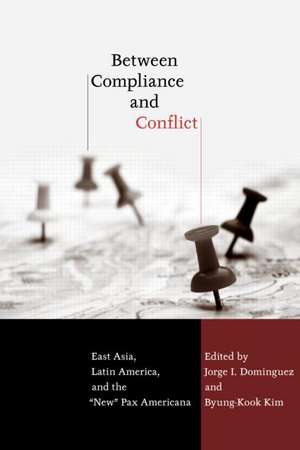Between Compliance and Conflict: East Asia, Latin America and the "New" Pax Americana
Editat de Jorge Dominguez, Byung-Kook Kimen Limba Engleză Paperback – 30 mar 2005
| Toate formatele și edițiile | Preț | Express |
|---|---|---|
| Paperback (1) | 438.56 lei 6-8 săpt. | |
| Taylor & Francis – 30 mar 2005 | 438.56 lei 6-8 săpt. | |
| Hardback (1) | 1280.10 lei 6-8 săpt. | |
| Taylor & Francis – 29 mar 2005 | 1280.10 lei 6-8 săpt. |
Preț: 438.56 lei
Nou
Puncte Express: 658
Preț estimativ în valută:
83.92€ • 87.85$ • 69.44£
83.92€ • 87.85$ • 69.44£
Carte tipărită la comandă
Livrare economică 05-19 aprilie
Preluare comenzi: 021 569.72.76
Specificații
ISBN-13: 9780415951258
ISBN-10: 0415951259
Pagini: 278
Ilustrații: 3 b/w images and 5 tables
Dimensiuni: 152 x 229 x 15 mm
Greutate: 0.51 kg
Ediția:1
Editura: Taylor & Francis
Colecția Routledge
Locul publicării:Oxford, United Kingdom
ISBN-10: 0415951259
Pagini: 278
Ilustrații: 3 b/w images and 5 tables
Dimensiuni: 152 x 229 x 15 mm
Greutate: 0.51 kg
Ediția:1
Editura: Taylor & Francis
Colecția Routledge
Locul publicării:Oxford, United Kingdom
Notă biografică
Jorge I. Domínguez, Byung-Kook Kim
Cuprins
1) Between Compliance and Conflict: Comparing U.S.-East Asian and U.S.-Latin American Relations,Jorge I. Domínguez, Harvard University, and Byung-Kook Kim, Korea University,2) A New Pax Americana? The U.S. Exercise of Hard Power East Asia and Latin America,Robert Paarlberg, Wellesley College,
Descriere
This book examines the responses to U.S. power in the two areas of the world where U.S. primacy was first successfully consolidated: East Asia and Latin America. The U.S. has faced no comparably powerful challengers to the exercise of its power in Latin America for much of the past century. It established its primacy over much of East Asia in the aftermath of WW II and extended its influence in the late 1970's and after the end of the Vietnam War through its entente with China to balance the Soviet Union. By contrast, the U.S. has always encountered rivals and challengers in Europe, has attempted unsuccessfully thus far to impose its primacy in the Middle East, and has paid only intermittent attention to South Asia and Africa. The essays in this volume will explore three important themes 1.) How do region-wide economic trends and arrangements sustain or modify U.S. influence in the region? 2.) How do rising powers in these regions (Japan, China, Brazil) reshape their policies to cope with the U.S. and 3.) How do new (South Korea) and old (Cuba) challengers to U.S. power shape their policies to account for the unrivaled exercise of U.S. power. This collection will place the United States at the hub of relations with countries in East Asia and Latin America and examine the new policies and new styles of engagement that are employed to address the prolonged U.S. interest in these areas-approaches from which the rest of the world might learn.












